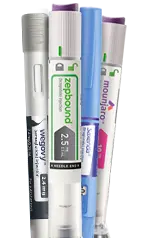Rybelsus vs. Ozempic: Which One’s Right for You?
Rybelsus and Ozempic – both prescribed for the treatment of type 2 diabetes and belonging to the class of GLP-1 receptor agonists – have gained recognition for their efficacy in managing blood sugar levels and promoting weight loss.
Get prescription weight loss medication online.
Find out if you're eligible for GLP-1s, and get started on your weight loss journey for as low as $75/month.


What is Rybelsus?
Rybelsus – the brand name for oral semaglutide – stands out as the first and only GLP-1 receptor agonist available in tablet form.
Approved by the FDA for type 2 diabetes treatment in 2019, Rybelsus has provided a convenient and effective alternative for those seeking an oral medication option.
The active ingredient – semaglutide – works by mimicking the effects of the naturally occurring hormone GLP-1. This hormone is known to regulate blood sugar levels and digestion while also suppressing appetite.
What is Ozempic?
Ozempic is the brand name for semaglutide, but it is delivered via subcutaneous injection.
Similar to Rybelsus, Ozempic falls within the GLP-1 receptor agonist class and was also approved by the FDA for the treatment of type 2 diabetes.
Given its injectable form, Ozempic provides a different administration option for those who may prefer injections over oral tablets.
Similarities and Differences of Rybelsus and Ozempic
While both Rybelsus and Ozempic share the same active ingredient there are some differences between the two medications.
Rybelsus, being an oral tablet, offers a more convenient option for patients who may be averse to injections.
However, the oral form of semaglutide requires a higher dosage compared to the injectable Ozempic to ensure proper absorption.
Dosages
The dosage of Rybelsus typically ranges from 3 mg to 14 mg once daily, with the initial dose usually set at 3 mg for the first 30 days. Following the initial period, the dosage can be increased to 7 mg as needed.
In some cases, further escalation to 14 mg may be considered depending on the patient's response and tolerance.
Ozempic, administered through subcutaneous injection, comes in a pre-filled pen device. The standard starting dose for Ozempic is 0.25 mg once a week for the first four weeks.
After this initial period, the dosage is increased to 0.5 mg once a week, providing a longer duration of action compared to the daily administration of Rybelsus.
Side effects
Both Rybelsus and Ozempic share common side effects associated with GLP-1 receptor agonists. Gastrointestinal symptoms, such as nausea, diarrhea, and vomiting, may occur with the use of either medication.
These side effects are typically mild to moderate in severity and tend to diminish over time as the body adjusts to the medication.
Key Point: Positive Side Effects of Rybelsus and Ozempic
Individuals with chronic conditions – such as hypertension and high cholesterol – who have taken Rybelsus and Ozempic have shown improvements in their health due to weight loss from these medications.
Both drugs have demonstrated cardiovascular benefits in clinical studies, showing a reduction in the risk of major adverse cardiovascular events in patients with type 2 diabetes and established cardiovascular disease.
Ready to achieve your weight loss goals?
Shed pounds with GLP-1 medication prescribed online by licensed healthcare providers for as low as $75/month.


Average cost
The cost of Rybelsus and Ozempic can vary based on factors such as insurance coverage, location, and specific dosage requirements. Generally, injectable medications like Ozempic may be more expensive than oral medications like Rybelsus.
Patients are encouraged to consult with their healthcare providers and insurance representatives to determine the most cost-effective option based on their individual circumstances.
Potential drug interactions with Rybelsus & Ozempic
Rybelsus and Ozempic, like any medications, may have potential interactions with other drugs. It is important to inform your healthcare provider about all the medications, supplements, and over the counter drugs you are taking to reduce the risk of adverse interactions.
Here are some potential drug interactions associated with Rybelsus:
Insulin and other oral medications: Combining Rybelsus with insulin and other oral medications used to treat diabetes may increase the risk of hypoglycemia.
Certain supplements: High doses of vitamin D or calcium supplements may reduce the absorption of Rybelsus.
Medications influencing kidney function: Medications that affect kidney function may influence the excretion of Rybelsus or its components.
Certain gastrointestinal medications: Drugs that affect gastrointestinal motility – such as antidiarrheals or laxatives – may potentially impact the absorption of Rybelsus.
Here are some potential drug interactions associated with Ozempic:
Insulin and other oral medications: Combining Ozempic with insulin and other oral medications used to treat diabetes may increase the risk of hypoglycemia.
Certain supplements: Using Ozempic and a chromium supplement may increase your risk of low blood sugar.
Certain gastrointestinal medications: Ozempic functions by delaying the emptying of the stomach, a process that can influence the absorption of specific oral medications within your body.
Rybelsus | Ozempic | |
|---|---|---|
Active Ingredient | Semaglutide | Semaglutide |
FDA-approved treatment for | Type 2 Diabetes | Type 2 Diabetes |
Form | Oral tablet | Injection |
Dosage | The starting dose is 3 mg once daily for 30 days, followed by an increase to 7 mg once daily and then up to 14 mg as needed | The starting dose is 0.25 mg, to be taken once weekly, and the maximum recommended dosage is 2 mg |
Potential drug interactions | Insulin and other oral medications that treat diabetes Vitamin D supplements Medications that affect kidney functions Drugs that affect gastrointestinal motility (such as antidiarrheals or laxatives) | Insulin and other medications that treat diabetes Drugs that affect gastrointestinal movement (such as antidiarrheals or laxatives) |
Common side effects | Gastrointestinal issues such as (nausea, diarrhea, abdominal pain, constipation, decreased appetite) | Gastrointestinal issues such as (nausea, diarrhea, abdominal pain, constipation, decreased appetite) |
Risks to consider | Pancreatitis, medullary thyroid carcinoma (MTC), renal impairment, hypoglycemia | Pancreatitis, medullary thyroid carcinoma (MTC), renal impairment, hypoglycemia |
Manufacturer | Novo Nordisk | Novo Nordisk |
Cost without insurance | $1,029 for a 30-day supply of tablets | $915-$1,000 per injection pen |
Which One is More Effective?
The effectiveness of Rybelsus and Ozempic in managing blood sugar levels is comparable. Clinical studies have shown that both medications significantly reduce HbA1c levels, which reflects average blood sugar levels over a three-month period.
The choice between Rybelsus and Ozempic often comes down to individual patient preferences, considering factors such as the preferred method of administration (oral vs. injectable) and personal tolerance for potential side effects.
How to Get a Prescription for Rybelsus or Ozempic
If you want to learn more about the difference between Rybelsus and Ozempic, LifeMD is here to help.
While both medications share the same active ingredient and demonstrate efficacy in managing blood sugar levels and support weight loss, the differences in dosage, administration method, and potential side effects.
Licensed medical professionals can support you through LifeMD’s Weight Management Program, which offers an individualized plan to help you achieve your weight loss goals.
More articles like this
Feel better with LifeMD.
Your doctor is online and ready to see you.
Join LifeMD for seamless, personalized care — combining expert medical guidance, convenient prescriptions, and 24/7 virtual access to urgent and primary care.

GLP-1
Zepbound® Wegovy® Saxenda®
This is it! Be part of the weight loss movement everyone’s talking about.
Get Started Now
 Medically reviewed and edited by
Medically reviewed and edited by 








